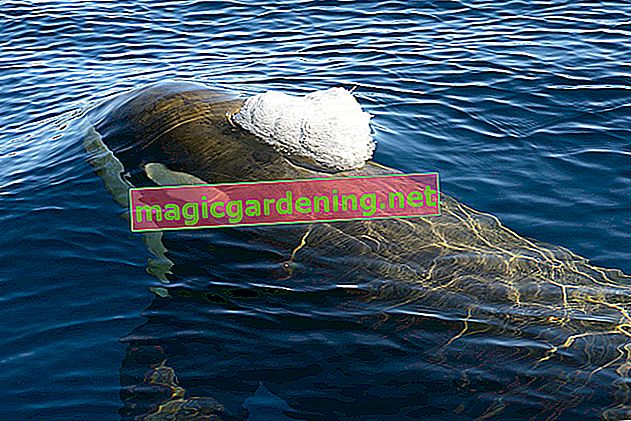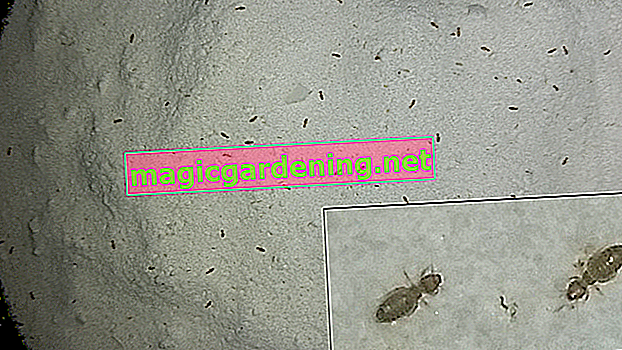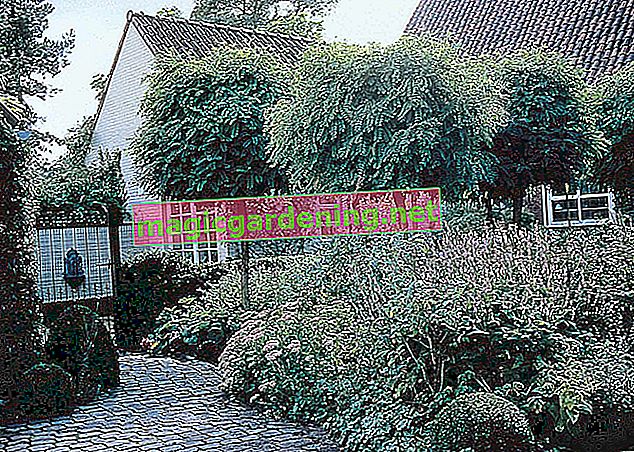
Cutting dogwood species-specifically - options at a glance
The success story of the multi-faceted dogwood genus is based on outstanding species and their unique attributes. If you have succumbed to the charm of spectacular colored wood dogwoods, the pruning is different from that of opulent flower dogwoods. And finally there is the local cornel, which fascinates us as a splendid early bloomer and spoils us with delicious berries. The following table gives an overview of the main cutting options for the most popular dogwood species in the home garden:
also read
- Planting dogwood properly
- Dogwood blooms in late spring
- Dogwood - care, cutting, wintering
| Art | botanical names | Cut option I. | target | Period | Cut option II | target |
|---|---|---|---|---|---|---|
| Redwood Dogwood, Siberian Dogwood, White Dogwood, Yellowwood Dogwood | Cornus alba, Cornus sericea, Cornus sanguinea | Radical cut | Formation of colored rods | Late February to early March | Maintenance and clearing cut | Promotion of the abundance of flowers |
| Flower dogwood, pagoda dogwood | Cornus kousa, Cornus florida, Cornus nutallii, Cornus controversa | Maintenance and clearing cut | Preservation of beauty and flowering | from the 10th year immediately after the flowering period | no cut | Give natural beauty a free hand |
| Cornelian cherry | Cornus mas | Upbringing | multi-stemmed shrub or single-stemmed wild fruit tree | during the first years of standing | Clearance cut | Prevention of old age |
| Carpet dogwood, Canadian dogwood, pillow dogwood | Cornus canadensis | Cut back the taken shoots | Opaque ground cover with weed suppression | in late winter, in good time before the fresh shoot | no cut | natural growth as a blooming ground cover |
Is there any uncertainty as to which type or variety of dogwood is in your garden? Then please do not make the decision based on the German trade name, which sometimes led to adventurous confusion. The only guarantee is the botanical name.
Boldly cutting colored dogwood - instructions for pruning
With the cut of colored dogwood, you can also choose between intensely colored shoots or beautiful flowers. You are faced with this decision because species with bright red, yellow or brownish-red branches bark after 3 years and lose their radiance. If there is a continuous pruning to keep the young ones colorful, the already established flower buds are regularly lost. The cut for each option is detailed below:
Preservation of the intensive shoot color:
- The best time is late February to early March
- In the third year of standing, cut off every second shoot at ground level
- Cut out the other half in the fourth year
- Let young shoots stand
- Alternatively, put the entire shrub on the cane every 3 years
- In the following years, thinning out the older, corking branches in favor of fresh shoots
- Alternatively, put the entire shrub on the cane every 3 years
Digression
Put on stick
With the term “put on the cane”, gardeners describe a radical pruning of trees. All shoots are shortened to a height of 20 to 30 centimeters. The bush sprouts cheerfully from the sleeping eyes on the rhizome. In contrast to this, dead wood is always cut off at ground level so that no dead stumps prevent young twigs from sprouting.Preservation of the abundance of flowers
- The best time is after the flowering period
- Only cut when arched branches touch the ground and take root there
- Cut back too long shoots to the apex of the arch
- In addition, clear out dead wood in late winter
Cutting back at the end of the flowering period does not collide with the creation of new buds for the next year's flowering period. Please do not wait too long to use the pruning shears. By mid-July at the latest, the pruning should be done in favor of flowering. From this point on, a dogwood begins to plant the buds for next year's flower festival.
background
Bird protection
Radical pruning measures on ornamental trees are subject to the provisions of the Federal Nature Conservation Act (BNatSchG). If you put a dogwood on the stick or do extensive tapering, the pruning must be completed before March 1st. To protect breeding birds and small nesting animals, Paragraph 39, Section 5 of the BNatSchG prohibits any disturbance of wild animals through pruning. Between March 1st and September 30th, light maintenance cuts are allowed, provided that wildlife can be excluded.Cut flower dogwood from time to time - this is how it works
Flower dogwoods are a floral revelation even without a cut. Wonderful species like Cornus florida and Cornus kousa do not age even in old age. Rather, gardeners can plan the lavish blossoms in every early summer, followed by decorative fruit bunches and bright foliage in autumn. Under normal conditions, you can carry out a maintenance and clearing cut from the 10th year on. How to do it:
- The best time is immediately after the flowering period until mid-July
- Cut out damaged and dried branches
- Remove shoots that are directed into the interior of the bush or that grow crosswise
- Cut excessively long branches that are bent to the ground by half
In addition, from the 10th year of standing, dead ground shoots are cut off at the base in intervals of 3 to 4 years in late winter for a light-flooded ornamental shrub. The figure below illustrates the cut for maintenance and clearing cuts on flower dogwoods.

Tips
One of the most famous dogwood varieties requires special treatment when pruning. Flower dogwood 'Venus' trumps with opulent flowers and furious autumn colors. However, the ornamental wood does not branch out well in the first few years. They convince the flowering bush of a dense, compact and flower-rich habit with a thorough cut. After the flowering period, shorten all shoots by a third.
Cornelian cherry - pruning focused on parenting pruning
The Cornelian cherry reveals its botanical relationship with the Cornus species only on closer inspection. As an early flowering wild fruit tree, the golden yellow flowers of Cornus mas shine at the same time as forsythia. The red berries in autumn are suitable for consumption and serve as a fruity ingredient for delicious jams, compotes and syrups. In addition, the Cornelian cherry thrives with the hardest and heaviest wood in all of Europe. With this mix of extraordinary attributes, pruning is reduced to training to become a bush or tree, supplemented by a clearing pruning at an advanced age.
The Cornelian cherry grows very slowly and usually bears its first fruits after 8 to 10 years . You can therefore devote yourself to upbringing in the first few years during the winter without impairing a possible harvest yield.
In late winter, choose 3 to 5 strong ground shoots as a framework for bush training. All other shoots are removed. The upbringing of the half trunk begins in late winter after planting with the strongest central shoot as the future trunk and 3 to 4 stable leading shoots. In the following year, shorten the scaffold shoots on the shrub and the leading shoots on the half-trunk by a third before budding begins. The next branch then begins. Side branches sprouting below the crown are removed, as are vertical shoots that compete with the trunk.
When a Cornelian cherry bears fruit for the first time, pruning is reduced to a minimum. If necessary, cut back branches that are too long after flowering. When cutting, keep in mind that with each withered flower you reduce the chance of delicious cornel cherries. You can thin out an older shrub or an aging crown in late winter.
Carpet dogwood - this is how the perennial cut
A ground cover should not be missing from the wide range of varied dogwood species. The carpet dogwood takes on this task with flying colors. As one of the few herbaceous perennials within the dogwood genus, a Cornus canadensis makes life easy for the gardener. In the middle of the winter time, the plant pulls in its leaves and shoots to rest. From mid-May the ground cover will report back with fresh shoots.
In view of the annual growth of 5 to 10 centimeters, pruning is not necessary for carpet dogwood. Many home gardeners consider the drawn-in, dead plant parts to be a nuisance. It is up to your individual decision to restore the well-groomed appearance through a floor-level cut back. Another advantage of cutting in late winter is that space is created for the young shoots to grow.
Taper cut brings momentum to growth
You can primarily prescribe a rejuvenating cut from colored wood dogwood, as these species and varieties are all well tolerated by cutting . The growth rockets within the genus make up for the lost drive volume in next to no time after a radical cut. With slowly growing Cornus species and varieties, the privacy factor is lost for a few years, while at the same time the first flowering period after a rejuvenation cut is a long time coming. How to skillfully make a taper cut:
- The best time is between the beginning of November and the end of February on a frost-free day
- Thoroughly clear out all dead wood beforehand
- Cut the remaining twigs back to 20 to 30 cm
- In the following year during the late winter, fix the shape with a correction cut
- Ideally, shorten the outer shoots a little more than twigs inside the bush
Flower dogwoods do not tolerate rejuvenation pruning. If a flowering shrub is aging against all expectations, restrained maintenance and clearing cuts in several stages have a chance of success. Start with small cuts in the outer shrub area and work your way into the interior of the wood year after year after the flowering period.
Digression
Tool
Dogwood wood is tough and resilient. Cutting older shrubs in particular can take a lot of effort for the gardener. While secateurs are sufficient for cutting one to two-year-old shoots, this does not apply to the thinning of outdated ground shoots. Two-hand pruning shears with optimized power transmission are recommended for cutting shoots up to 35 millimeters. One-handed and two-handed scissors are optionally available with a bypass or anvil mechanism. For cutting branches with a diameter of more than 35 millimeters, we recommend a handy folding saw (€ 17.70 on Amazon *) so that you can work effectively even in dense undergrowth.Don't cut just anywhere - the skillful cutting technique
A clean cut is the key to success when cutting dogwood. Frayed cuts, damaged buds, bruised shoots and stumps that are too long are perfect targets for pathogens and pests. Please use your scissors and saw in a targeted manner so that an ornamental shrub can benefit fully from pruning. This cutting technique has proven itself excellently in wood care:
- Sharpen blades and saw blades and disinfect with alcohol
- Select the intersection point at a distance of 4 to 6 millimeters above an outward-facing pair of buds
- Hold the tool at a slight angle, facing away from the opposite buds, as shown in the figure below
Always place scissors in such a way that the cutting blade rests on the part of the shoot that remains.

frequently asked Questions
What to do when a dogwood sprawls
Some of the most beautiful dogwood species form numerous runners that spread throughout the garden. Put an end to the invasive campaign of conquest with scissors and pruning saws. The best time is in summer because a cut in the middle of the vegetation period significantly weakens growth. Cut back all shoots at ground level. Now the shrub cannot store any reserves through its leaves, which reduces its vigor.
Are cut dogwood shoots suitable for propagation?
The clippings of colored wood dogwood, such as the popular Cornus alba, are far too good to dispose of. In every annual, bright red shoot there is the potential for a splendid ornamental shrub. To do this, cut one or more cuttings 20 centimeters long above and below a pair of buds. In a partially shaded, protected propagation bed, put two thirds of the shoot sections in humus-rich, loose soil so that they quickly take root.
Typical cutting errors on dogwood
Successful pruning of dogwood shrubs also depends on avoiding typical pruning mistakes. The following table lists the most common mishaps that home gardeners can make while maintaining pruning, with tips for correcting them:
| error | episode | correction |
|---|---|---|
| Deadwood thinned out too timidly | no or only a few young branches grow back | Cut off dead shoots at ground level; leave no stumps |
| Colored wood dogwood never tapered | no bright bark color in winter | put the shrub on the cane in late winter |
| Arching branches are rooted in the ground | Formation of runners, invasive spread in the garden | Cut back too long an overhang to a pair of buds at the apex |
Tips
Dogwood and cornel cherries are highly valued in the design of Japanese gardens. Thanks to the uncomplicated pruning, Cornus bushes fit seamlessly into the Asian garden culture. The pretty flowers and decorative fruits act as the ideal contrast program to authentic basic elements such as white gravel and evergreen coniferous bonsai.









